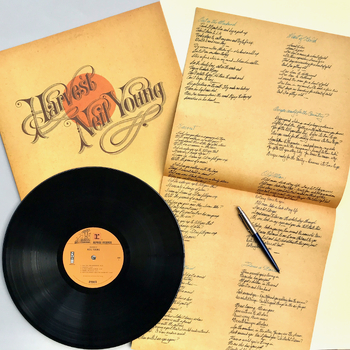HARVEST GOLD
Author: Bruce Jenkins Date Posted:11 November 2022

A true legend of rock music, Neil Young has been writing, performing and recording his songs for in excess of five and a half decades. With well over fifty live and studio albums the Neil Young catalogue is a daunting prospect, yet some records stand out and have stood the test of time, becoming benchmarks for American music. Harvest, released in February 1972, is one of those.
After leaving his home in Toronto, Canada to try and make it as a musician in California, the Neil Young story unfolded quickly. First there were Buffalo Springfield LPs with Stephen Stills, then two solo albums. Next up was a reunion with Stills in the trio Crosby Stills and Nash, promptly renamed to include Young. The famous CSN&Y quartet performed at Woodstock (though Young demanded to be excluded from the film and recordings). And that, friends, is all before the end of 1969.
Things only accelerated after that. The much acclaimed Crosby Stills Nash & Young album Déjà Vu came out in March 1970 and an extensive tour followed, documented on the double album 4 Way Street. These concerts, plus the success of Déjà Vu, significantly raised Young’s profile so that his next album, After The Gold Rush, was very well received on release in September 1970. It is an album of melancholic beauty and poetic introspection with a side order of righteous rage thrown in ("Southern Man"). Yet the generally inward-looking approach did not prevent After The Gold Rush reaching the top ten of album charts in the US, UK and Canada.
The way was prepared for Neil Young to break through in the rapidly expanding Album Orientated Rock (AOR) market of the early 1970s, and he did just that with his fourth album. On the back of two timeless singles—"Heart Of Gold" and "Old Man"—Harvest topped charts all around the world… Australia, the UK and USA, France, Canada of course… even Norwegian fans took the LP to the top.
Many will be familiar with Young’s famous response to international stardom and acclaim. He described "Heart Of Gold"—his only #1 single—as the song that "put me in the middle of the road. Traveling there soon became a bore, so I headed for the ditch. A rougher ride but I saw more interesting people there." (From the liner notes to the excellent compilation album Decade.) Young’s own road was certainly bumpy for the next few years. Two drug-related deaths in his inner circle hit him hard. Time Fades Away, the 1973 LP documenting the Harvest tour, is a raging, tortured and deeply moving record that is highly recommended for those who want to dig deeper into Young’s work. It forms the first part of the so-called "Ditch Trilogy", followed by the bleak On The Beach and bleaker Tonight’s The Night.
But let us return to Harvest, Neil Young’s best known LP. In honour of its fiftieth anniversary a lavish re-issue is slated for mid-December release. The first record is, naturally, the original Harvest album, remastered. A second LP has a revealing solo performance recorded for the BBC In Concert series in February 1971. A DVD of this concert is included, as well as a second DVD of the previously unreleased full-length film Harvest Time, documenting the making of the album. A quaint inclusion is a 7" single of three rarely heard outtakes from the sessions. Finally, as expected, there is a beautifully produced book accompanying the set. The package is a bountiful harvest for Neil Young fans.
I’ve been to Hollywood, I’ve been to Redwood
I crossed the ocean for a heart of gold
I’ve been in my mind, it’s such a fine line
That keeps me searchin’ for a heart of gold
Neil Percival Young
Born 12 November 1945
Toronto, Ontario, Canada
© Bruce Jenkins—November 2022






